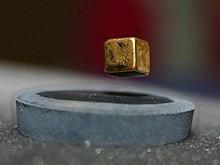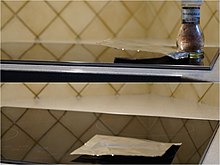Levitation (technique)

Levitation ( Latin levitas = lightness) describes the free floating of an object. For this purpose, the acting weight is compensated with the help of a force and an object is positioned in the room, with no direct contact with the floor or solid objects. Some methods require a gaseous medium (e.g. air) to transmit power, which must be around the object.
Compressed air levitation
Levitation of an object can be achieved, for example, by blowing air against the object , as in air hockey . It is used in bodyflying in parachuting training . Alternatively, air can be pushed down from the object. This principle is used in a hovercraft , which allows the vehicle to float on an air cushion.
Acoustic levitation
Here, small samples are positioned in the pressure node of a stationary ultrasonic field without contact. This procedure was first tested in 1933. In space research under the influence of microgravity in weightlessness, it enables material science experiments to be carried out, since small samples can be precisely positioned without contact.
The acoustic levitation in the standing wave field is based on the forces that act on the respective sample in the alternating pressure field of the standing ultrasonic waves. Thereby axial and radial forces occur. Using acoustic levitation, for example, styrofoam balls or water droplets can be made to float.
On the verge of acoustic levitation, the ultrasonic air bearing, which is caused by the near field effect in the ultrasonic field, counts . It is primarily used for transporting and gripping flat objects.
Magnetic levitation
Electric and magnetic forces enable real levitation, i.e. levitation that does not require any mechanical contact: Bodies can repel one another depending on their charge or polarity, and so the force of gravity can be balanced. However, there are practical problems with this method, because Earnshaw's theorem states that static fields , such as those of normal permanent magnets , cannot create stable equilibrium positions . So at best you can manage to let one permanent magnet hover briefly over another, but even the smallest disturbances (wind, vibrations) cause it to crash. However, there are several ways to still create stable levitation.
Levitron
A magnetic top can levitate in a static field, because its gyroscopic movement aligns itself with a disturbance in such a way that stability is maintained.
Active field control
If the position of the body to be levitated is recorded by sensors , control loops can adjust the field so that disturbances are compensated. This process can be implemented with various methods, it is currently the only one that has been used on a larger scale beyond a toy scale, best known for magnetic levitation trains . Magnetic floating couplings are commercially available for scales with which z. B. a sample located in a vacuum vessel can be weighed from the outside through a stainless steel wall.
Diamagnetism
Diamagnetic substances are repelled by magnetic poles - both north and south poles. As a result, the potential field looks different for them, the Earnshaw theorem does not apply, and there are stable equilibrium positions. Graphite plates, for example, can float above permanent magnets; with sufficiently strong ambient fields, even small permanent magnets can be kept floating between human fingers (which are also diamagnetic). Superconductors are perfectly diamagnetic; they can be used to achieve particularly impressive floating effects.
Levitation in a high frequency alternating magnetic field
Eddy currents are induced in a conductor by the alternating magnetic field . This creates the magnetic field that is directed opposite to the field of the magnet. Normal conductors such as copper or aluminum behave like diamagnetic substances. The following solutions are practicable as a possible arrangement of conductors and magnets to one another:
- Fast rotating magnet (or conductor), for example, the Hendo hoverboard uses fast rotating permanent magnets over a copper surface
- Magnet and conductor moving quickly relative to each other (this is to be used in the Inductrack system for magnetic track technology)
- A conductor that is in the alternating field of an electromagnet (high frequency is necessary)
- Crystal growth is possible with the levitation crucible - a variant of the Czochralski process , in which the melt of the material from which the crystal is drawn is held in suspension by the same electromagnetic alternating field that heats it.
- With power electronics , comparable to those in a frequency converter , it is possible to generate electromagnetic fields with any direction of movement. As with an eddy current brake , a non- ferromagnetic surface will tend to rest relative to the field. If the field now moves, a vehicle can be raised and accelerated in any direction. It's comparable to a magnetic levitation train , but not rail-bound.
Optical levitation
In optical levitation, mass particles are made to float using laser light. This happens via the impulses of the photons , the radiation pressure , which counteract the weight . A sufficiently high intensity of the laser beam is required for this . For objects a few µm in size - in the earth's gravitational field - lasers of the order of 1 watt are required. The optical tweezers are an example of this methodology.
literature
- Hyung-Suk Han, et al .: Magnetic levitation - Maglev technology and applications. Springer, Dordrecht 2016, ISBN 978-94-017-7522-9 .
Web links
- Online simulation of the Levitron (Java applet with source code and equations)
- Electronically controlled magnetic levitation of a ball (functional description and circuit diagram)
- Magnetic levitation of a stationary or moving object (Hendo hoverboard)





